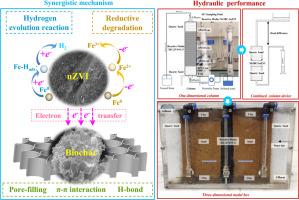Insights into the remediation of trichloroethene contaminated groundwater by simulated permeable reactive barrier with biochar-iron composites: Synergistic mechanism and hydraulic performance
IF 6.3
2区 环境科学与生态学
Q1 ENVIRONMENTAL SCIENCES
引用次数: 0
Abstract
Biochar and zero-valent iron are promising materials for the removal of trichloroethylene (TCE) from groundwater, but further research is still required on the synergistic mechanism and hydraulic performance in the permeable reactive barriers (PRBs) with biochar-iron composites. In this work, biochar-iron composites were synthesized by two different methods, and subjected to the microscopic analysis, batch experiments and the PRB’s model tests. The results indicated that the removal rates of TCE on biochar-iron composites reached above 90 %, and the optimal removal conditions were the initial pH of 6.0 and a biochar/iron mass ratio of 5:1. The removal of TCE on biochar-iron composites followed the pseudo-second-order and Freundlich models, and the maximum adsorption capacity of TCE was 25.95 mg/g. The adsorption of biochar and dechlorination of nZVI dominated the removal of TCE. Biochar significantly enhanced the dechlorination of TCE on nZVI through modifying the electrochemical characteristics to lower its corrosion potential of nZVI, promote direct electron transfer, and improve electronic transfer capability. M-5BC-1nZVI exhibited excellent hydraulic performance for maintaining an adequate permeability coefficient (10−6 to 10−5 m/s).

生物炭-铁复合材料模拟渗透反应屏障修复三氯乙烯污染地下水:协同机制和水力性能
生物炭和零价铁是去除地下水中三氯乙烯(TCE)的有前景的材料,但生物炭-铁复合材料在渗透反应屏障(PRBs)中的协同作用机理和水力性能还有待进一步研究。本文采用两种不同的方法合成了生物炭-铁复合材料,并进行了显微分析、批量实验和PRB模型试验。结果表明,生物炭-铁复合材料对TCE的去除率可达90%以上,最佳去除条件为初始pH为6.0,生物炭/铁质量比为5:1。生物炭-铁复合材料对TCE的去除符合拟二阶和Freundlich模型,TCE的最大吸附量为25.95 mg/g。生物炭的吸附和nZVI的脱氯对TCE的去除起主要作用。生物炭通过改变电化学特性,降低TCE对nZVI的腐蚀电位,促进电子直接转移,提高电子转移能力,显著增强了TCE对nZVI的脱氯作用。m - 5bc - 1nzvi表现出优异的水力性能,保持了足够的渗透系数(10−6 ~ 10−5 m/s)。
本文章由计算机程序翻译,如有差异,请以英文原文为准。
求助全文
约1分钟内获得全文
求助全文
来源期刊

Journal of Environmental Sciences-china
环境科学-环境科学
CiteScore
13.70
自引率
0.00%
发文量
6354
审稿时长
2.6 months
期刊介绍:
The Journal of Environmental Sciences is an international journal started in 1989. The journal is devoted to publish original, peer-reviewed research papers on main aspects of environmental sciences, such as environmental chemistry, environmental biology, ecology, geosciences and environmental physics. Appropriate subjects include basic and applied research on atmospheric, terrestrial and aquatic environments, pollution control and abatement technology, conservation of natural resources, environmental health and toxicology. Announcements of international environmental science meetings and other recent information are also included.
 求助内容:
求助内容: 应助结果提醒方式:
应助结果提醒方式:


